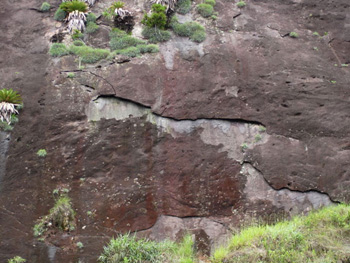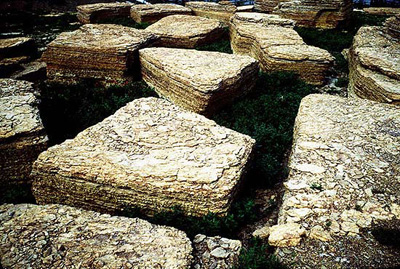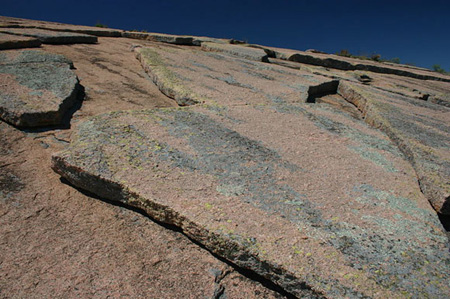Physical Weathering
Under the larger categories of the causes of physical weathering (water, wind, ice) are smaller categories that include: exfoliation, frost wedging, pressure release, haloclasty, biological activity, and hydraulic action, which also cause physical weathering. Click through the tabs to see an explanation of each type.
Exfoliation

Exfoliation is a type of physical weathering that is characterized by rocks breaking apart in thin layers. In this picture you can see how an outer layer is being weathered off of the larger rock. Exfoliation happens because of thermal stress on a rock. It is most common in desert areas where daytime temperatures are very hot but nighttime temperatures are remarkably colder. The rocks expand by day but cool and contract at night, putting pressure on the outside layers, which then begin to peel off.
Frost Wedging

Frost wedging is a type of physical weathering that involves rocks or soil minerals being broken apart by repeated cycles of freezing and thawing. It happens when water accumulates in tiny cracks within rocks or in soil pores, freezes, contracts, and then exerts pressure on the rocks and soils. Frost wedging is common in mountainous areas where temperatures often fall below freezing at night.
Pressure Release

Pressure release is a type of physical weathering that occurs when a rock is relieved of overlying pressure and expands in response. As the rock expands, outer layers begin to break off in sheets, as you can see in this image. For example, if erosion processes remove a large mass of overlying material from a rock, the rock is suddenly under much less pressure than it was before. Being under less pressure allows it to expand, and this expansion leads to the fracturing you see in this image.
Haloclasty

Haloclasty is a type of physical weathering caused by salt crystal growth. It commonly occurs along ocean shorelines where salt water can creep into the cracks in rocks. The water later evaporates, but it leaves salt crystals behind. When the salt crystals are heated they expand and exert pressure on the rock. Haloclasty leaves rocks with a distinctive honeycomb appearance.
Biological Activity

Living things can also be agents of physical weathering. Plant roots can exert pressure on rocks and soil when they grow within cracks or soil pores. As the roots grow, they press outward on the rock, eventually leading to the disintegration of the rock. Burrowing animals can also contribute to physical weathering by digging through the soil and opening up channels that accelerate other types of weathering.
Hydraulic Action

Waves that beat along a shoreline are a type of physical weathering. In this type of weathering, water is forced into cracks within a rock. As the water is forced inward, so is a small amount of air, which becomes trapped within the cracks. When the wave retreats, the trapped air is suddenly released with explosive force, wearing down the rocks.